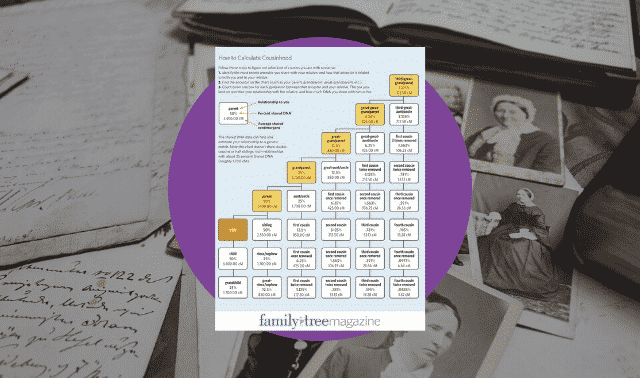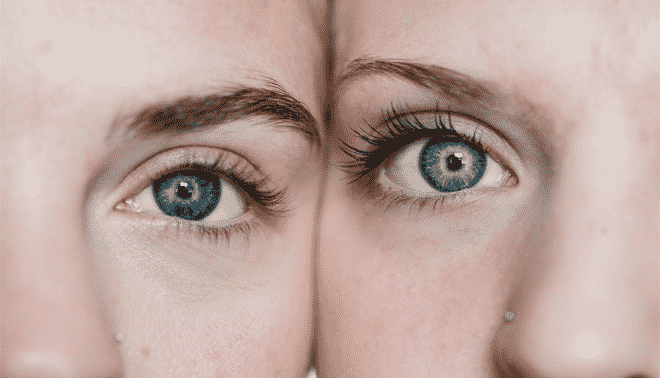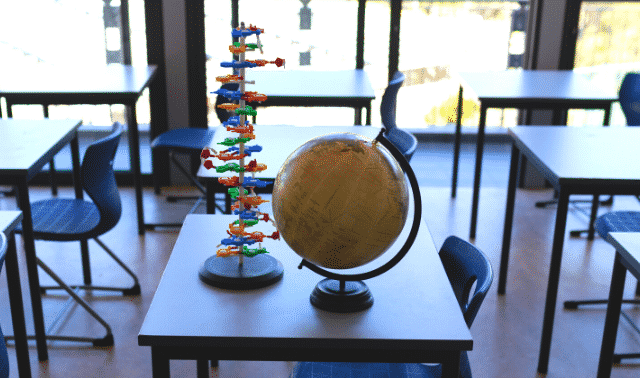Sign up for the Family Tree Newsletter! Plus, you’ll receive our 10 Essential Genealogy Research Forms PDF as a special thank you.
Get Your Free Genealogy Forms
"*" indicates required fields

“Triangulation” is a broad term with application in many fields, from psychology to politics. In genetic genealogy, triangulation mirrors the process used by surveyors, who employ multiple triangles to help deduce the exact landscape of a particular area. Here’s how to use triangulation to your advantage when analyzing your DNA matches.
Genetic genealogists create triangles from groups of three autosomal DNA matches to get a better picture of how each member of the group is related to the others. Commonalities among the three individuals’ family trees may indicate shared ancestors. For example, if two group members have common Smith ancestors in Colonial Massachusetts, the third group member—who perhaps hasn’t yet reached that far back in her tree—might theorize she’s also connected to the Smiths and turn to traditional genealogical records to investigate.
You don’t have to be a DNA expert to start using triangulation to your advantage. You just have to have autosomal DNA test results from one of the four major testing companies (23andMe, AncestryDNA, Family Tree DNA or MyHeritage DNA), a known cousin with autosomal test results, and some shared matches. We’ll show you how to triangulate your way to family tree success.
How to Triangulate DNA Matches
While the triangle used to play music and the triangle giving you trouble in math class are very different from the genetic genealogist’s triangle, there are some definite similarities among them: Without fail, every triangle has three sides, connected at three points. Let’s discuss each point in the DNA triangle and how to identify it.
Point A
The first point is you (you’re already a third of the way there!). What makes you the perfect starting point? Well, it’s your DNA of course—your autosomal DNA, the stuff that came half from mom and half from dad. Of your enormous DNA record, the testing companies evaluate about 800,000 pieces. Now stop for just a second to appreciate the strength of your position on this triangle and the significance of those 800,000 pieces. They can identify you uniquely, apart from everyone else in the whole world. Not only that, but these pieces of DNA also form a kind of map of your ancestors and your ancestry. Think of your DNA as various points scattered across time and space, outlining the vast landscape of your heritage. Contained in your very own DNA is a record of the places your ancestors lived, their families, and even their secrets.
The trick, of course, is to convert that system of dots into a network of information that you can use to discover your past. This is one of the greatest strengths of genetic genealogy—the ability to find records that were previously lost. Just as the surveyor uses triangulation of multiple points to discover the contours of a landscape, a genetic genealogist can use the multiple points of her DNA to triangulate with others and obtain a clearer picture of her own ancestral lines.
Point B
The second point on your triangle is any other person on your match list. Remember, individuals who show up on your match page are there because they share DNA with you. That shared DNA means they also share an ancestor with you.

Now, not all matches are created equal. You want what we’ll call a “Best Match” to occupy Point B on your triangle. Generally, you’ll usually find your Best Matches on the first few pages of your match list. See the “Creating DNA Triangles for Richmond Claunch” section for steps to evaluating which matches are your best to use for triangulation.
Point C
With so many possible connections, it’s easy to see why you need a way to narrow your search. This is where the third point on your triangle comes in. When you add a third person with his genetics and genealogy, you harness the power of triangulation to help you discover which of the eight great-great-grandparent or 16 third-great-grandparent couples are the most likely connecting point for you and your two matches.
To find Point C on your triangle, you need a match with specific characteristics. Point C needs to share DNA with both Point A (you), and Point B (your Best Match). You can find that person most easily using a tool provided by your testing company.
Use this tool to find a list of Point C candidates on your match page, as well as the match page of Point B. So if all three of you share DNA, there’s an excellent possibility that you all share a common ancestor.
This, my fellow genetic genealogists, is the crux of triangulation: Each person on this list of shared matches becomes Point C on your triangle. Just by using the shared matches tool, you now have multiple triangles, all with you, Point B, and then the list of shared matches vying for Point C. With your shared match list in hand, you can evaluate the genealogies of all of the shared matches for similarities. If you can find out how they’re related to each other, then you’ll have a good idea how you might be related to them.
That’s all good, but how do you use triangulation in your research? Let’s look at two case studies to explore different ways you can apply this method to your genealogy.
Case Study 1: Triangulating Known Cousins
In an attempt to use the principles of triangulation to identify his mystery maternal grandfather, Edward has tested multiple cousins on his mom’s side and his dad’s side. Anytime a new match shows up on his match list, he can use triangulation with his known cousins to help him figure out if the match is related to this grandfather and thus might help solve the question of his identity.
Recently, a man named Victor showed up as a new second-cousin match to Edward. This means that Edward is Point A and Victor is Point B. To find Point C, we used the shared matches tool to find others who have DNA in common with both Edward and Victor.
Unfortunately, all the Point C matches were on Edward’s paternal side, meaning Victor was just another paternal match, and not someone who could help him find his mystery maternal grandfather.
But still, Edward was intrigued. He thought he knew all his paternal second cousins—but who was Victor? Through further comparisons and triangulations, Edward discovered that Victor shared more cMs with one cousin, Peter, than any other. Using the number of shared cMs and doing further research eventually showed that Victor’s mom was Peter’s half sibling. Victor may have eventually figured this out on his own, but Edward, with his network of known tested cousins, was able to put it all together relatively quickly using triangulation.
In Edward’s case, you can see that triangulation with known cousins can help you place your close matches into particular ancestral “bins,” making it relatively easy to at least identify which parent or grandparent the match belongs to. Next, let’s explore the principle of triangulation in a situation where we don’t have the benefit of so many known tested cousins.
Case Study 2: Looking for Fourth-Great-Grandparents
Richmond Virginia Claunch, my third-great-grandfather on my dad’s side, was born in Texas in 1860. My best theory about his parentage was that … well, I think he … OK, I had absolutely no idea.
So I turned to my autosomal DNA matches. Any DNA I have from Richard came through my dad, and Dad has more of Richard’s DNA than I do. Therefore, my dad will represent me at Point A of our triangle (I’ll still talk about this as my point, just to make things easier). For Point B, ideally, I want someone who descends from a different child of Richmond than my dad does. That means the shared DNA comes from Richmond or his wife, Lilly.
But I wasn’t in touch with any of my dad’s third cousins. So instead of a known cousin, I needed to find a Best Match—remember, that’s my closest genetic match who also shares a genealogical element of interest, such as a surname or location. So I searched my autosomal DNA matches on AncestryDNA (you can do this at the top of the View All Matches page) for matches with the surname Claunch in their family trees. I found several matches, all candidates for Point B on my triangle. Looking through posted pedigrees, I found a match with the user name RS, whose tree shows he’s a descendant of Richmond and Lilly’s daughter Bessie Claunch. Perfect! (If I hadn’t found this match, I’d look for a match with Claunch relatives from Texas.)
Now I had Point A (my dad) and Point B (RS), and all I needed was Point C. To find it, I viewed the shared matches between RS and my dad. There were eight, as shown in the illustration on the next page. Any of these people could be placed at Point C on the triangle. In fact, I actually created several triangles to form a “Genetic Network.” Here’s how:
My dad + RS + each of the eight shared matches = 8 triangles.
My dad + No. 1 of those eight shared matches + the two new people who shared matches with both my dad and No. 1 (but not with RS) = 2 more triangles. These people are numbers 9 and 10.
Creating DNA Triangles for Richmond Claunch
As I looked for candidates for my Richmond Claunch triangle, I noted that match No. 1 doesn’t share DNA with Nos. 5, 7 or 8, all of whom do share DNA with RS.
Remember that RS descends from Richmond and Lilly’s daughter, so he has both Richmond’s and Lilly’s DNA. This probably means that match No. 1 shares DNA with either Richmond or Lilly. Examining the family trees of Nos. 5, 7 and 8 reveals the Harvey surname in No. 7’s pedigree. Lilly’s maiden name was Harvey. To further check out this connection, I can triangulate my dad and No. 7, looking in No. 7’s shared matches list for Nos. 5 and 8. Sure enough, they’re in there. This initial analysis suggests that Nos. 5, 7 and 8 are related on Lilly’s side, not Richmond’s. Genealogy research can confirm this theory.

Now I can make a new “Best Match” list (shown in the third column on the opposite page), composed of test-takers who share DNA with both me and someone else (RS) I have reason to believe is related to Richmond or Lilly, and therefore are prime sources of information. The next step is to do genealogy, looking at the online pedigrees of these Best Matches and trying to figure out how they’re related to each other.
If a person doesn’t have a tree linked to his or her results, search for the user name to see if you can find one that isn’t linked to the DNA results. Also see if the person has posted a tree under that user name at other family tree websites.
Look at names of ancestors first, and then at locations of birth and death. If you can figure out how these matches are related to each other, you can be reasonably certain that their common ancestor also is your ancestor. I noticed that a few of my Best Matches share the ancestor Joseph Claunch, who was born in 1803 in Tennessee and married Anna Carter. To determine how this Joseph and Anna might fit into my pedigree, I need to examine the genetic relationship of his descendants to my dad, and the genealogical relationship of each match to Joseph.
Let’s take another of my dad’s matches, DV. Joseph is DV’s third-great-grandfather. If Joseph were also my dad’s ancestor, DV and my dad would be fourth cousins. Their predicted genetic relationship, based on shared cMs, is fourth cousins, so this genealogical hypothesis fits. Two more matches, both genetic and genealogical fourth cousins, further corroborate this story. Looking at the genealogy, my Richmond is in a good position to be Joseph and Anna’s grandson. Since he carries the Claunch surname, he’d have to be the son of one of their sons. With that in mind, let’s turn to the genealogy and see what we can find.
Joseph is in the St. Clair, Ala., census in 1840, but it gives ages and genders of household members—no names. The family is in the same place in 1850, but several children are already grown and gone. Although I haven’t yet figured out exactly who Richmond’s parents are, triangulating my dad’s DNA matches has given me several avenues to research: Joseph and Anna had sons I still need to investigate. I can extend the pedigrees of other genetic matches in my Best Matches list to see where they lead. Another group of triangulated genetic matches within my Best Matches have a Claunch ancestor in Virginia who ended up in Alabama, so I need to take a closer look at that line. Importantly, from the combination of genetics and genealogy, I know that my Claunches are associated with Claunches in St. Clair, Ala., and later in Red Rock, Texas.
The simple process of identifying two other people to occupy points B and C on your triangle, and using them to create a list of Best Matches from which to draw more information, is really all there is to triangulation.
Some genetic genealogists take this idea of triangulation a step further. Instead of simply using a shared matches tool to gather others for Point C, they compare actual chromosome data. This extra step requires a tool called a chromosome browser (the GEDMatch website offers one, as does Family Tree DNA), which lets you visualize the DNA you share with someone. Some people like to look for shared DNA segments as evidence of a triangulated relationship. You might hear them say, “We all share a segment on chromosome 11, and so we must all be cousins!”
Viewing chromosome data can be fun, but it certainly isn’t necessary for triangulation success. All that matters is that you share DNA, it doesn’t really matter where that piece of DNA is on a chromosome. So don’t worry if you aren’t into spreadsheets and raw data. You can triangulate if you follow the simple shape of the triangle and its three important points.
Your best matches—the ones who make the best candidates for the points on your genetic genealogy triangles—are the ones who share the most centimorgans with you.
Using Centimorgans
Centiwhats? Centimorgans are how we measure your pieces of DNA. It isn’t quite as simple as an inch or a centimeter, but for our purposes, you can think of centimorgans that way. Your testing company tells you how many total centimorgans (cMs) you share.
This number can come in handy when you’re trying to figure out how closely you’re related to someone based on a relationship range, such as “2nd to 4th cousins.” These three steps will help you use the total number of cMs to better understand your relationship to someone.
1. Find the total number of shared cMs for you and your match
At MyHeritage and Family Tree DNA, the number of cMs is shown on the main match page. It’s there for 23andMe as well, but shown in percentage form (to convert, multiply your percentage by 68, for example: 3.125 x 68=212.5 cMs). At AncestryDNA, click on the match you’re interested in, and then click on the little question mark under the relationship range to see the total number of shared cMs.
2. Look up that number in a table
Blaine Bettinger spearheaded the Shared cM Project to gather statistics on cMs real genealogists share with their known relatives. The result is a range of shared cMs for each relationship (sibling, first cousin, aunt/uncle, etc), with an average number of cMs the relatives are found to share. For example, first cousins on average share 880 cMs; second cousins, 245; and third cousins, 89. Examine the full table at the Genetic Genealogist for relationships that fit your genetics.
3. Check the genealogy of the match
Let’s say you and your match share 87 cMs. You decide, based on the testing company’s predicted relationship and the number of shared cMs, that you and your match should be third cousins. Traditional third cousins share a set of great-great-grandparents. That means you need to look at your match’s eight sets of great-great-grandparents to see if you can figure out which is likely to be your connecting ancestral couple.
Many people, though, don’t know the names of all their great-great-grandparents. And even if they do, “uneven” generations (i.e., a couple having a child at an unusually young or old age) can lead to ancestral connections that aren’t in the exact generation you expect them to be in. So instead of looking for your common ancestor among the eight great-great-grandparent couples, you may need to look for them in your match’s 16 third-great-grandparent couples. If you can’t find a common ancestor, look for surnames and places that match those in your tree.
Tip: On AncestryDNA, other test-takers can now share their results with you, allowing you to view their match lists as you would your own matches.

Related Reads
A version of this article appeared in the July/August 2017 issue of Family Tree Magazine. Last updated: March 2023











